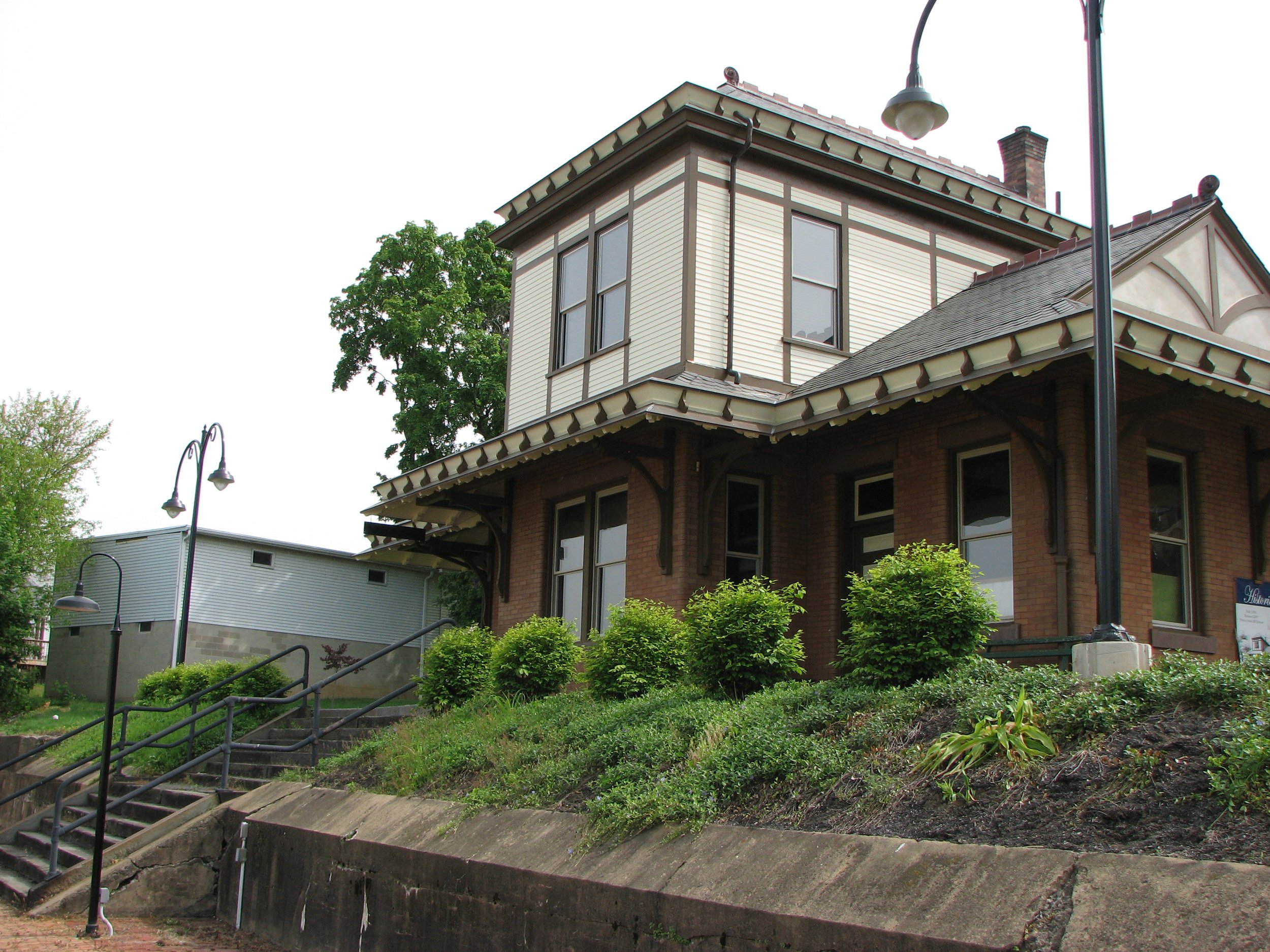
RAILROAD PASSENGER STATION

RIVER, RAIL, and an Alligator
“The large pond on the terrace also provided a home for Millersburg’s ‘weather forecasting’ alligator.”
The historic passenger station is located on Center Street, Millersburg. It is a two-story, brick and frame building in the Queen Anne style. It features a deep porch around three sides. The property also includes the stone foundation of the original baggage house.
In 1896, the Millersburg Board of Trade asked the Northern Central Railway to build a station within the borough limits and circulated a petition signed by many citizens and a large number of the Traveling Salesman's Association. A site was selected for a new station in August 1897 and the Northern Central purchased the Rathvan property at the foot of Center Street for the passenger station and another property at the foot of Moore Street for a new freight station. Bricklayers and carpenters completed the station by March 1898.
On March 30, 1898 the first ticket was sold and on March 31, the first train, the Niagara Express, stopped at the new depot and J.B. Seal, editor of the Herald, who wrote numerous editorials in support of a new station, was the first passenger to get off the at the new location. The next day, April 1, 1898, the new depot was opened to the public in ceremonial fashion with a band playing and hundreds of spectators cheering the event. An article in the Harrisburg Telegraph described this new station as follows:
"It is situated on Centre Street in the heart of town, a block from the post office and two blocks from the hotels. It is a two story building about ten feet above track level. The first story is of light raiston brick lain in red mortar with Hummelstown brownstone trim-mings. The second story is frame of neat design with ornamental stucco on the gables. The roof is slate with terra cotta ridges. Throughout the building the wood is chestnut in natural color, while the walls and ceilings are stamped steel. It is heated by steam, lighted inside and out by electricity and provided with running water. The building was erected by Harman & Jones, contractors, of Williamsport, Pa."
"The ticket office occupies a bay window on the west side flanked by the two waiting rooms with toilet rems on the opposite side. On the second floor are two well-lighted offices, on: occupied by Assistant Trainmaster Maurey, the other by Supervisor Gumbes. The space between the tracks and bank has been planked the length of the site and beyond there are walks of crushed stone along the tracks up to North Street and down half way to Union Street.
The baggage is handled in a small two-story house south of the station with an elevator connecting the train floor and delivery floor. Linemen are now connecting the new station with the old by telephone. The freight and telegraph offices are still at the old location, the latter operating a three lever set of distance signals just put in to protect the movement of the Lykens Valley trains between the junction and passenger station."
In 1899 trees and a hedge were planted. On the southern side of the steps leading to the tracks the name Millersburg was spelled out with colored plants. Surrounding the building was a lawn with flower gardens. In an area on the north side was a fishpond and above the station, up the steps toward Market Street there was a second fishpond stocked with huge goldfish. The retaining wall along the track platform was added in July 1913.
The large pond on the terrace also provided a home for Millersburg’s “weather forecasting” alligator. An aritcle in the April 1917 Sentinel reads as follows:
"Alligators ways indicate rain or shine. Wilson Heckert, janitor at the passenger station has been caring for the alligator, which lives in the terrace pond during the warm months. Mr. Heckert has a winter home for the alligator on the second floor of the station, consisting of a tub with two inches of water and a box of dry sand placed on a platform. When the alligator sleeps on the sand, Mr. Heckert says there will be rain (or snow) within 36 hours."
The last passenger train stopped on July 4, 1960, although it remained a flag stop until the advent of Amtrak on April 30, 1971. By then, service had been reduced to a tri-weekly train called the Buffalo Day Express. The abandoned station was purchased by Brubaker Tool Corp. and used for storage. In 1982, Brubaker donated the building to the Historical Society.
For the next 20 years the society manned the building, painting and repairing when needed. In 2002, the society received a Transportation Enhancement grant to do the work and (after an 18-month effort) the station was listed on the National Register for Historic Places.
That same year a local Boy Scout proposed restoring the brick platform along the tracks for his Eagle Scout project. After two years, the project was completed and the society installed a fence along the platform. The architects for this project were McKissick & Associates of Harrisburg, Pa. And the contractor was Dorgan & Zuck of York, Pa.




